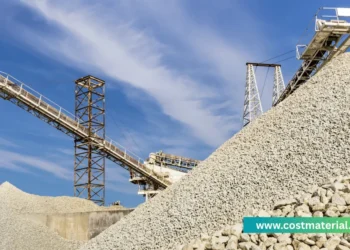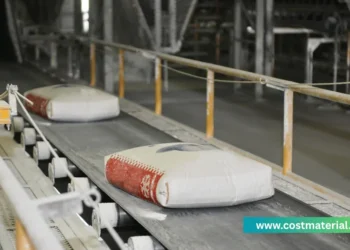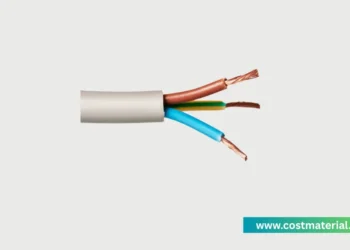Table of Contents
1 Understanding GI Wire: An Essential Material
Galvanized Iron (GI) wire is a fundamental material. It plays a crucial role in countless industries. For instance, it’s vital in construction, agriculture, and manufacturing. This type of wire is made from steel. Subsequently, it undergoes a galvanization process. A protective zinc coating is applied. This coating provides excellent resistance. It protects against rust and corrosion. Therefore, GI wire offers durability. It also delivers strength and versatility. These qualities make it a preferred choice.
GI wire’s versatility is truly remarkable. It is used in various applications. For example, it forms fences. It also provides reinforcement in concrete. Furthermore, it binds materials together. Its importance cannot be overstated. Hence, understanding its market value is key. This is especially true for the year 2025. Knowing the GI wire price list is crucial for budgeting. It helps in planning projects effectively.
2 Factors Influencing GI Wire Prices in 2025
Several factors impact the GI wire price list in 2025. These elements contribute to price fluctuations. Therefore, they should be carefully considered.
Raw Material Costs
First, the cost of raw materials is a major driver. Steel is the primary component. Zinc is also essential for galvanization. Global steel and zinc prices fluctuate. Consequently, this directly affects GI wire costs. Market dynamics for these commodities are always changing. For example, mining output impacts supply. International trade policies also play a role. Thus, monitoring these raw material markets is important.
Manufacturing Processes
Next, manufacturing processes influence prices. The type of galvanization matters. Hot-dip galvanization is common. It creates a thicker, more durable coating. Electro-galvanization is another method. It results in a thinner coating. Production efficiency also affects cost. High-tech machinery can lower production expenses. Labor costs also contribute to the final price. Therefore, these operational aspects are significant.
Market Demand and Supply
Furthermore, market demand and supply dictate prices. High demand often leads to higher prices. Conversely, oversupply can drive prices down. Construction booms, for instance, increase demand. Infrastructure projects also boost consumption. Economic growth generally fuels greater demand. Conversely, economic slowdowns can reduce it. Global and local supply chains are critical too. Disruptions can affect availability.
Import/Export Dynamics
Import and export dynamics also impact pricing. The Philippines imports some GI wire. Tariffs and trade agreements can affect costs. Exchange rates also play a significant role. A stronger peso might make imports cheaper. However, a weaker peso increases import costs. Therefore, international trade policies are influential. They shape the local GI wire price list.
Logistics and Distribution
Finally, logistics and distribution costs are relevant. Shipping expenses add to the final price. Fuel costs directly influence transportation. Storage and warehousing expenses are also involved. Local distribution networks impact accessibility. Areas with fewer suppliers might see higher prices. Remote locations also typically incur higher delivery fees. Therefore, these operational costs are factored in.
3 GI Wire Gauges and Their Common Uses
GI wire comes in various gauges. Gauge refers to the wire’s thickness. A lower gauge number indicates a thicker wire. Conversely, a higher gauge number means a thinner wire. Each gauge serves specific purposes. Understanding these uses is important. It helps in selecting the correct wire. This also impacts the overall cost.
- Gauge #8 to #12: These are thicker gauges. They are often used for heavy-duty applications. For instance, they reinforce concrete. They also secure rebar in construction. Additionally, they form robust fences. This gauge offers high tensile strength.
- Gauge #14 to #16: These are medium-thickness wires. They are very popular for general use. For example, they are used for tying and binding. Agricultural fencing also uses these gauges. They provide a good balance of strength and flexibility. Many construction sites rely on these.
- Gauge #18 to #22: These are thinner gauges. They are typically used for lighter applications. They work well for crafts and gardening. Floral arrangements often utilize these. They are also employed in certain mesh applications. Their flexibility is a key advantage.
Choosing the right gauge is essential. It ensures the project’s success. Moreover, it optimizes material costs. Always consider the intended application. Match the wire gauge to its purpose.
4 GI Wire Price List 2025 Philippines
The following table provides estimated price ranges for common GI wire gauges in the Philippines for mid-2025. These prices are per kilogram (kg) or per roll, as GI wire is often sold in both formats. Please consider these as a general guide. For precise and current pricing, always contact multiple local suppliers, hardware stores, and distributors in your area.
GI Wire Gauge (SWG) | Approx. Diameter (mm) | Common Weight (per roll/kg) | Estimated Price (PHP per kg) | Estimated Price (PHP per roll) |
| #8 | 4.06 | 25 kg – 35 kg | ₱100 – ₱135 | ₱2,500 – ₱4,725 |
| #10 | 3.25 | 25 kg – 35 kg | ₱100 – ₱135 | ₱2,500 – ₱4,725 |
| #12 | 2.64 | 20 kg – 30 kg | ₱105 – ₱140 | ₱2,100 – ₱4,200 |
| #14 | 2.03 | 18 kg – 25 kg | ₱110 – ₱145 | ₱1,980 – ₱3,625 |
| #16 | 1.63 | 15 kg – 20 kg | ₱115 – ₱150 | ₱1,725 – ₱3,000 |
| #18 | 1.22 | 10 kg – 15 kg | ₱120 – ₱155 | ₱1,200 – ₱2,325 |
| #20 | 0.91 | 5 kg – 10 kg | ₱125 – ₱160 | ₱625 – ₱1,600 |
| #22 | 0.71 | 1 kg – 5 kg | ₱130 – ₱170 | ₱130 – ₱850 |
5 Tips for Buying GI Wire
Purchasing GI wire requires some consideration. Here are a few tips to help you. These will ensure a smooth buying experience.
First, know your required gauge and weight. This is paramount. Different projects need different wire strengths. Therefore, precise specifications are essential. Avoid overbuying or underbuying.
Second, compare prices from multiple suppliers. Do not settle for the first offer. Price differences can be significant. This is especially true for large quantities. Gather at least three quotes.
Third, inquire about bulk discounts. Many suppliers offer reduced rates. This applies to larger orders. If you need a substantial amount, ask for it. This can save you a considerable sum.
Fourth, check the quality of the galvanization. A good zinc coating is vital. It ensures the wire’s longevity. Look for a uniform and smooth finish. Avoid wires with visible flaking or rust. High-quality galvanization prevents premature corrosion.
Fifth, consider the brand reputation. Established brands often indicate reliability. They adhere to strict quality standards. Research customer feedback. Choose reputable manufacturers.
Lastly, factor in delivery costs and lead times. Some suppliers offer free delivery. Others may charge extra. Also, ensure the delivery schedule meets your project needs. Timely delivery is often critical.
6 Ensuring Quality and Durability
Quality assurance is paramount for GI wire. Its durability depends on manufacturing standards. Hot-dip galvanization is a superior process. It provides a thicker zinc layer. This layer resists rust effectively. It extends the wire’s lifespan significantly.
Always look for certifications. Reputable manufacturers adhere to industry standards. These standards guarantee product quality. Checking for consistent wire thickness is also important. Inconsistencies can affect strength. A uniform diameter ensures even load distribution.
Proper storage of GI wire is also key. Store it in a dry environment. Protect it from moisture. This prevents premature corrosion. Even galvanized wire can degrade. It can rust if exposed to constant humidity. Therefore, good storage practices are crucial.
Consider the environment where the wire will be used. For harsh conditions, thicker galvanization is better. Coastal areas, for example, are highly corrosive. Therefore, they demand superior protection. Investing in higher quality wire pays off. It reduces replacement and maintenance costs.
7 The Future Outlook for GI Wire Prices
The GI wire price list in 2025 is subject to change. Several global and local trends will influence future prices. The global economy plays a significant role. Economic stability often leads to stable prices. Growth can drive demand up. Recessions might reduce it.
Steel and zinc markets are continuously evolving. New mining discoveries affect supply. Global trade policies can shift. Geopolitical events also have an impact. These factors introduce volatility. Therefore, prices might fluctuate.
Furthermore, technological advancements could affect production costs. More efficient manufacturing methods might emerge. This could potentially lower prices. However, increased environmental regulations might raise them. Sustainable practices sometimes come with higher initial costs.
Local infrastructure development will also be a factor. Ongoing government projects require vast amounts of wire. Private sector construction also contributes. These demands keep the market active. Thus, strong local demand can maintain prices. Conversely, a slowdown could lead to price reductions.
It’s wise for consumers to stay informed. Monitor market trends regularly. Consult with suppliers often. This proactive approach helps in securing the best deals. It also ensures access to needed materials.
8 Summary
The GI wire price list for 2025 reflects a dynamic market. Several factors influence pricing. These include raw material costs, manufacturing, and demand. Import/export dynamics and logistics are also significant. Understanding these elements is essential. It aids in informed purchasing decisions. Various gauges serve different purposes. Selecting the correct gauge is crucial. Always compare prices from multiple sources. Prioritize quality and reputable brands. This ensures durability and longevity. The market outlook remains influenced by global and local economic factors. Staying updated on trends is advisable. Ultimately, proper planning and research lead to successful projects.
Did you find this blog post helpful? Share it to others! For more construction material price lists, check our other blog post.





